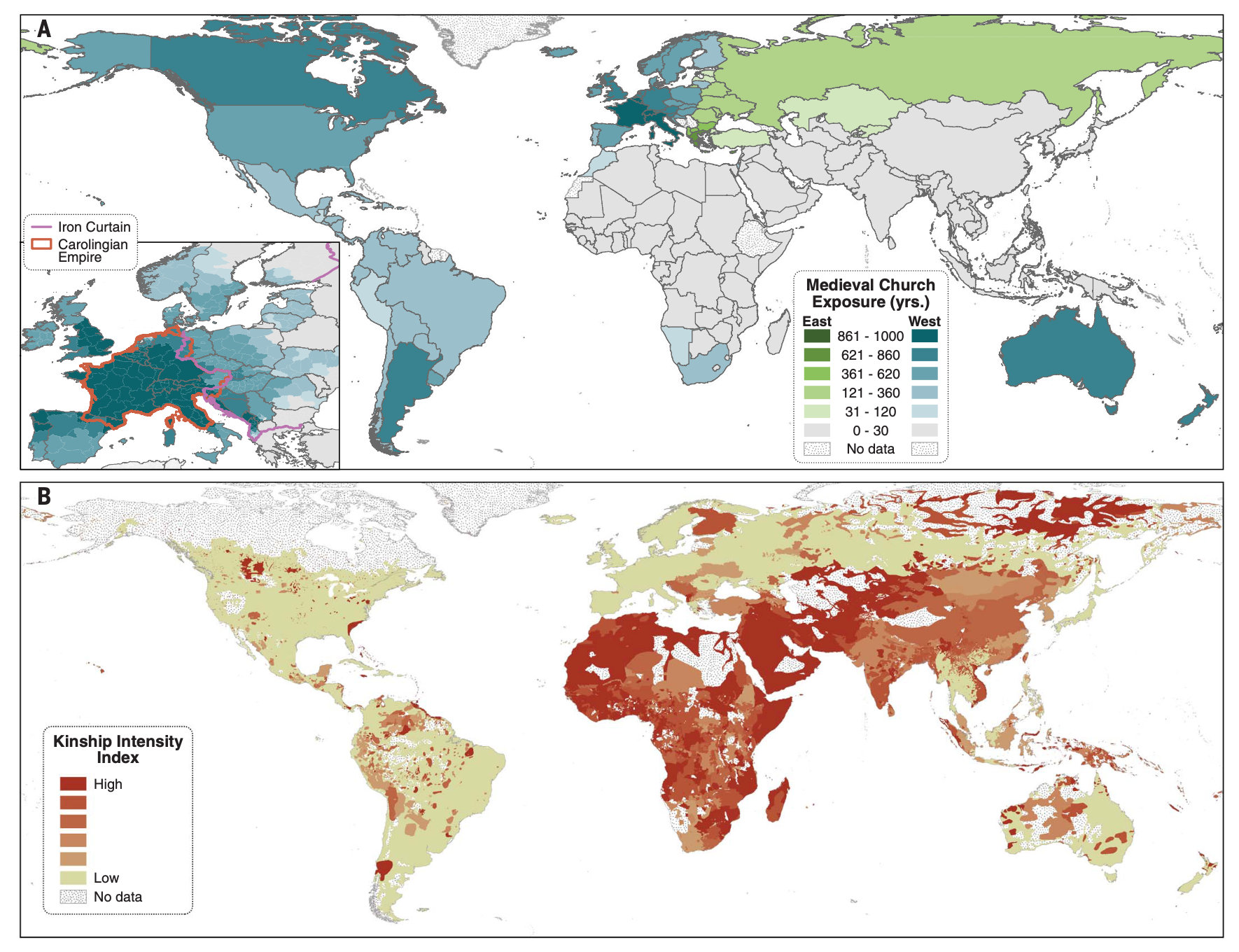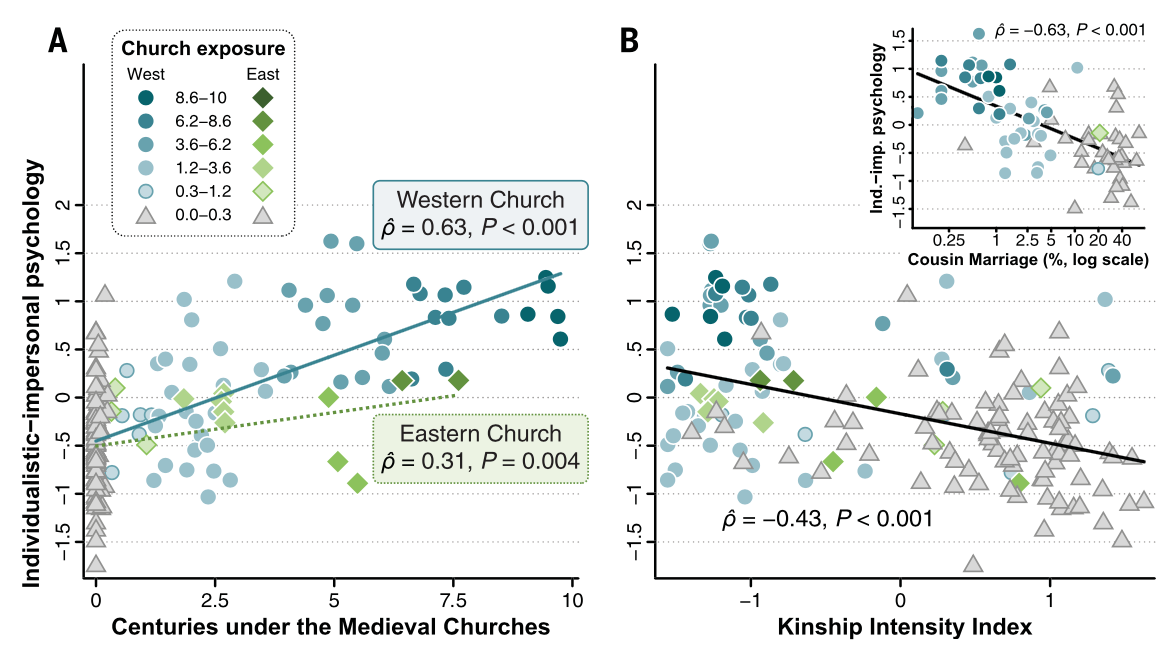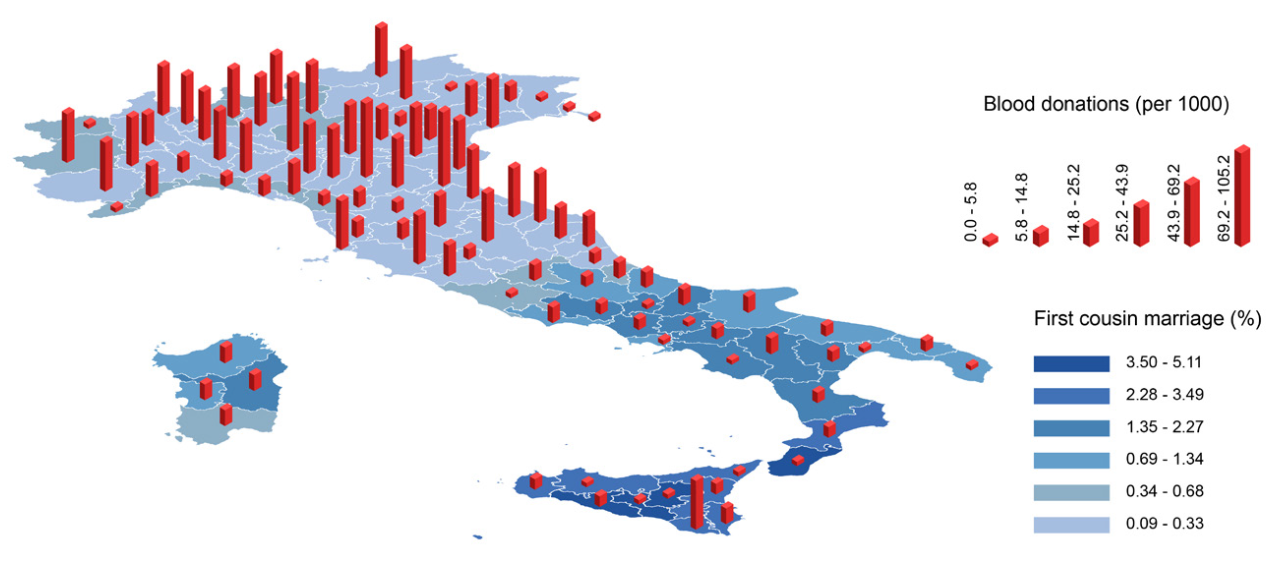Church and Kinship Ties
The Catholic Church is responsible for the destruction of kin-based institutions and the gradual modification of the psychology of people under its influence towards WEIRD

Numerous studies show that human populations in different parts of the planet significantly differ in psychological traits, with the WEIRD group—Western, Educated, Industrialized, Rich, and Democratic—standing out. People from this group are more individualistic, independent, more trusting of strangers, less conformist, and demonstrate less group loyalty. Although these patterns are well-documented, their causes are rarely studied. Addressing this gap is the article by Schulz, J. F., Bahrami-Rad, D., Beauchamp, J. P., & Henrich, J. (2019). The Church, intensive kinship, and global psychological variation. Science, 366(6466), eaau5141, which posits that the demographic policies of the Roman Catholic Church are the root cause of the emergence of WEIRD people.
Hypothesis
The logical structure of the article rests on three assertions. Firstly, anthropological evidence suggests that various kin-based institutions have been the foundation of social order in most parts of the world since ancient times. With the development of agriculture, cultural evolution increasingly promoted social norms such as cousin marriages, clan formation, multi-generational cohabitation, which strengthened social ties, interdependence, and cooperation.
Secondly, psychological research shows that people’s motivations, emotions, and perceptions are shaped by the social norms they live within while growing up. In societies with intensive kin-based institutions, people adapt to the collectivist demands of their tight social networks. Conformity, obedience, and group loyalty are rewarded, while individualism, independence, and creativity are not encouraged.
Thirdly, historical research shows that the Western Church systematically dismantled intensive kin-based institutions during the Middle Ages (e.g., prohibiting cousin marriages up to the sixth degree, including step-relatives, promoting consensual rather than arranged marriages, discouraging adoption and remarriage). In contrast, other major religions pursued opposite policies: Zoroastrianism encouraged cousin marriages, and Islam promotes polygamy and a unique marriage practice where a daughter marries her father's brother. The Church's policies led to the decline of kin-based institutions in Europe by 1500, resulting in relatively independent nuclear families composed only of parents and their minor children.
The hypothesis proposed in the article is that populations with prolonged exposure to the Roman Church are more individualistic, less conformist, and more prosocial; and that long-term historical exposure to the Western Church is associated with less intensive kin-based institutions.
Methodology
To test the hypothesis, three types of variables were created. Firstly, databases were constructed on the penetration and duration of Church influence on various countries worldwide, and more specifically, on regions within Europe. Secondly, using anthropological data, an index of kinship intensity (KII) was created. This composite index is based on the proportion of close-relative marriages, polygamy, extended family cohabitation, clan organization, and communal endogamy.
Thirdly, based on existing literature, 24 different psychological variables were constructed to characterize the populations of individual countries as well as regions of Europe. One such variable, for example, is dishonesty, measured in experiments with dice. Participants were asked to secretly roll a six-sided die, with their reward being proportional to the number rolled—meaning a roll of 5 earned the most money. The trick is that a roll of 6 earned nothing. After rolling, participants recorded the result and reported it to the experimenters. Deviation from a uniform distribution allows an assessment of dishonesty, correlating with national-level measures of corruption and tax evasion.
Results
The hypothesis about the Church's influence on the psychological profiles of populations was tested in several cases. The image below shows the depth of Church influence and KII across countries worldwide. The correlation is evident at a glance.

Prolonged exposure to the Western Church leads to increased individualism and decreased KII. Every 500 years of exposure to the Western Church results in a 91% reduction in cousin marriages.

A twofold increase in cousin marriages in Italy is associated with an 8-unit decrease in blood donation per 1,000 people, which is significant given an average level of 28 units per 1,000 people. Italians from provinces with higher rates of close-relative marriages prefer to borrow money from relatives and friends rather than banks, prefer cash for payments, and hold more savings in cash rather than in banks or stocks.

Based on these and other results, which we omit here for brevity, the authors conclude that their initial hypothesis is correct: The Catholic Church is responsible for the destruction of kin-based institutions and the gradual modification of the psychology of people under its influence towards WEIRD.
Criticism
The article analyzes the relationships between an excessively large number of parameters. While the degree of Church penetration and the duration of its influence on a population seem fairly reasonable, the KII is compiled from five separate parameters, and the psychological variables from 24 parameters! Which of these are truly important, and which could be omitted? Do they correlate with each other, and is this set redundant?
It is quite surprising that all three variables are measured at different times. The Church's influence is recorded as of 1500, under the pretext of increased migration and population mixing after this date. The KII is calculated from data around 1900, supposedly because industrialization began to dismantle traditional societies worldwide after that. The psychological profiles of populations are determined at the end of the 20th and the beginning of the 21st centuries. It is unclear why these three different variables, measured at three different times, should logically be related.
Some psychological parameters, while clever, seem absurd. For example, the degree of nepotism in countries is based on an analysis of the familial ties of around 100 top executives in each country. One factor for assessing honesty involves analyzing unpaid parking fines, with the sample being UN diplomats in New York between 1997-2002. Many parameters are based on surveys, which are inherently dubious sources of data. These shortcomings are partly offset by the large total number of parameters, offering hope of "washing out" individual artifacts.
The main issue is that the article is written within an institutional paradigm. A certain institution is identified as somehow producing changes in society. Key questions remain outside the scope of the study: why did this institution arise, why did it pursue such policies and not others, and why did it arise when and where it did. Such articles, while accurately noting certain patterns, merely create an illusion of a real answer about the actual causes of phenomena.



Comments ()